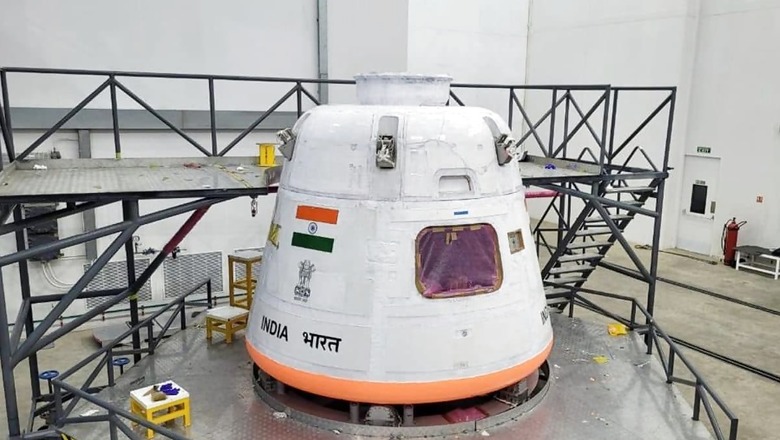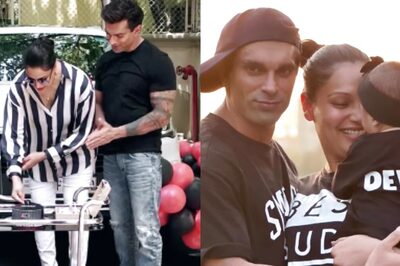
views
In the first of 20 big tests that ISRO has planned so as to meet targets set by Prime Minister Narendra Modi, it will be launching unmanned flight tests for the ambitious Gaganyaan mission from Sriharikota on Saturday (October 21). With a boost of Rs 9,000 crore by the central government, India wants to establish a space station by 2035 and send an astronaut to the moon by 2040.
It is an important day for Gaganyaan, India’s first human space programme, which will be launching unmanned flight tests to demonstrate the performance of the crew module escape system. And, significantly so, follows the success of Chandrayaan-3.
“Gaganyaan is challenging but very doable as India has all the necessary technology, and Rs 9,000 crore have already been sanctioned by the government,” Dr Unnikrishnan Nair, director of Vikram Sarabhai Space Centre at ISRO told NDTV.
“Humans will inhabit the moon sooner than later and India, a country of 1.4 billion, can’t be left behind so ISRO is preparing to give India independent access to space for its citizens on its own steam,” he was quoted as saying.
Gaganyaan aims at demonstrating ISRO’s capability to launch a human crew to an orbit of 400 km and bringing them safely back to earth by landing in Indian sea waters.
Here is all you need to know as ISRO goes live with Gaganyaan from Sriharikota on the morning of October 21:
- Under the Gaganyaan human spaceflight mission, ISRO will begin unmanned flight tests with the launch of a test vehicle between 7 am and 9 am to demonstrate the performance of the crew escape system. “Mission Gaganyaan: The TV-D1 test flight is scheduled for October 21, 2023 between 7 am and 9 am from SDSC-SHAR, Sriharikota,” ISRO posted on social media platform X.
- This crucial test will answer questions as to what happens to astronauts if things go wrong; the separation of the test capsule from the rocket; emergency opening of parachutes before the crew escape system lands in sea waters among others.
- According to ISRO chairman S Somanath, three more test vehicle missions will be launched under Gaganyaan after the test flight on Saturday.
- The test vehicle development flight (TV-D1) is aimed at testing the crew module (CM) that will carry Indian astronauts during the human spaceflight late next year.
- This involves launching the unmanned crew module to outer space, bringing it back to earth and recovering it after touchdown in the Bay of Bengal. “The first test vehicle flight (of the Gaganyaan mission) will be conducted on October 21. After that, we have planned for three more test missions, D2, D3, D4. We will hold thorough tests during the test flight sequence,” Somanath had earlier said.
- So, what is a test flight all about? ISRO said the test vehicle is a single-stage liquid rocket developed for this abort mission. The payloads consist of the CM and crew escape system (CES) with their fast-acting solid motors, along with CM fairing (CMF) and interface adaptors.
- ISRO further said the CES with CM will be separated from the test vehicle at an altitude of about 17 km. Then, the abort sequence will be autonomously executed commencing with the separation of the CES and deployment of the series of parachutes, finally ending in the safe touchdown of CM in the sea, about 10 km from the coast of Sriharikota.
- During a manned flight for Gaganyaan, the CM is where the astronauts will be contained in a pressurised Earth-like atmospheric condition. The CM is under different stages of development at present.
- For this test flight, the CM is an unpressurised version that has completed its integration and testing. “With its complete set of parachutes, recovery aids actuation systems and pyros (pyrotechnic device used to separate spacecraft from rocket), the avionics systems in CM are in a dual redundant mode configuration for navigation, sequencing, telemetry, instrumentation and power. The CM in this mission is extensively instrumented to capture the flight data for evaluation of the performance of various systems,” ISRO said.
- The CM will be recovered after touchdown in the Bay of Bengal, using a dedicated vessel and diving team from the Indian Navy.
When, where, how to watch
The Flight Test Vehicle Abort Mission-1 for Gaganyaan is scheduled for launch from the first launchpad at SDSC-SHAR in Sriharikota on October 21, commencing at 8:30 am. The launch will be broadcast live on DD News, while ISRO will also livestream it on its official website and social media platforms.
(With PTI inputs)














Comments
0 comment